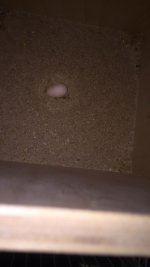Sunnytheparakeet
New member
- Sep 9, 2018
- 10
- 12
I adopted two parakeets from a neighbor. Male and female. There was a breeding box already in the cage and I found out the female had laid an egg! I’m not too familiar with birds as I am a new bird owner (I’m learning quickly). She is on a good diet (seeds, pellets, veggies and mineral block). I just wanted to know if her egg seemed normal? Is it supposed to be that shape?
Attachments
Last edited:
